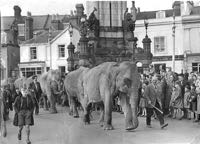
Elephants in Exeter
A page of trivia about elephants in Exeter
Page added 2nd March 2014
Back to Photo essays
The earliest recorded elephant in the country was an animal imported by Emperor Claudius during 43 AD, to Colchester in Essex. However, the people of the Dumnonii tribe who inhabited the Bartholomew Street area of Caerwysc never had the luxury of spying such a monster. The nearest the inhabitants of Isca Dumnoniorum got to an elephant was a Roman coin imported from a North African colony that showed an elephant stamping on a scorpion. They probably thought that an elephant was about 6 inches long when compared to a scorpion, so the size of a real animal would have been a surprise.
Bishop William Brewer (1224-1244) spent 1227 to 1235 on the sixth Crusade to the Holy Land. It is thought that on his return he brought with him drawings of some of the exotic creatures and plants that he saw on his travels. It was these drawings that were used as the source for the 49 carvings made on the misericords (tip up seats) in the Cathedral. The carvings included mermaids, dragons, lions, leopards and an elephant. The latter carving is thought to be the earliest depiction of an elephant in the country. The elephant is the only one to still be on public display.
That the inhabitants of Exeter were familiar with elephants in the 18th century is shown with the naming of the Elephant Inn in North Street. Travelling menageries were popular from about 1700, run by showmen satisfying the public thirst for the exotic. Lions and tigers were popular, along with elephants. Travelling menageries gradually morphed into circuses.
The Royal Albert Memorial Museum (RAMM) have a 'mounted' male African elephant on display. The records appear to show that it was shot by Charles Peel in the forest of the Aberdare Mountains, East Africa and presented to the museum in 1919.
Until a more enlightened age, performing elephants were a popular part of the circus. In 1904, Lord John Sanger and Sons Royal Hippodrome Circus visited Exeter. The elephants performed as a fire brigade, where they drilled, answered a night alarm, and put out a fire by squirting water from their trunks onto a house on fire. In 1911, Capt., George and his educated elephants performed at the Old Fair Field, St Thomas as part of the Grand International Railroad Circus. In 1937 the Miniature Olympia Circus performed at the Theatre Royal:
“Then there are the three splendid elephants. Docile, mammoth creatures, these, who are in the charge of Capt. Jerry Clarke and Madame Clarke. The confined space in which these intelligent creatures have to act makes no difference, and they are as careful and deliberate in their movements as any humans. They dance, play instruments, enjoy supper and perform other antics with ease and precision.”
Many people still have memories of elephants being led through the streets of Exeter from St David’s Station to Exhibition Fields or the George V playing fields at Countess Wear. Now, the closest elephant to Exeter can be found at Paignton Zoo, where resides Duchess, an African elephant.
During a publicity weekend for the Isca Photographic Library by Peter Thomas in 2014, a full sized artificial elephant was driven into Princesshay Square on the back of a trailer. That is the last time that an elephant of any sort has been seen in the city.
Source: The Story of Exeter by Hazel Harvey, British Library Newspaper Archive, dsnell.co.uk, jesuschristsavior.net/Crusades.html, rammcollections.org.uk.
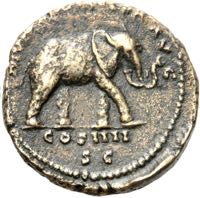
A Roman coin showing an elephant. Roman coins with an elephant stamping on a scorpion have been found in Exeter.
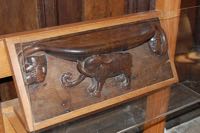
The earliest depiction of an elephant in Britain. The carving is on a misericord at the Cathedral. Creative Commons Julian P Guffogg.
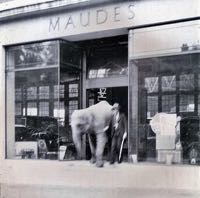
An elephant from the Theatre Royal was used as a publicity stunt at Maudes Garage, New North Road - 1930s. Photo Paul Martin.
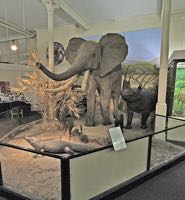
The 'mounted' African elephant at RAMM. Photo © David Cornforth
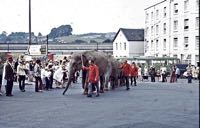
Elephants from Roberts Bros., Circus were unloaded at St David's and walked to the circus ground (1970s). Photo Alan H Mazonowicz.
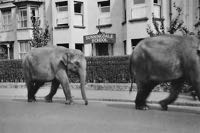
Circus elephants passing Sunningdale School in the Topsham Road in the early 1950s. Photo Martin Roberts.
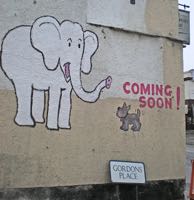
This image of a white elephant appeared on the wall of the gun-shop in Heavitree in protest at the then proposed Heavitree arch.
│ Top of Page │
